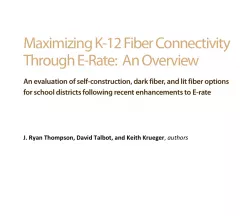
Maximizing K-12 Fiber Connectivity Through E-Rate: An Overview
An evaluation of self-construction, dark fiber, and lit fiber options for school districts following recent enhancements to E-rate
Authored by J. Ryan Thompson, David Talbot, and Keith Krueger
The federal E-rate program provides up to $3.9 billion annually to subsidize the provision of high-speed Internet access to schools and libraries. Recent revisions to the program greatly expand the options for how such service can be provisioned. Notably, school districts can now seek reimbursement for the costs of building their own fiber optic networks. What’s more, municipalities and counties can inexpensively add more fiber to such networks to serve wider community needs.
This new toolkit released by the Berkman Center in partnership with CoSN (the Consortium for School Networking), provides school system leaders the guidance to understand and leverage this newly expanded program. The report, Maximizing K-12 Fiber Connectivity Through E-Rate: An Overview comes as schools are feeling a bandwidth crunch. A recent CoSN survey revealed that 68 percent of district technology officers believe their school systems do not have the bandwidth to meet their district’s connectivity demands in the next 18 months.
- Part One provides an overview of the E-rate program and the types of fiber optic network projects that are eligible for reimbursement through the program. Through case studies, it also shares how three school systems managed their fiber connectivity challenges.
- Part Two includes an additional case study that details how a school district’s E-rate reimbursement for a fiber “self-build” could save the municipality or county significantly on a wider fiber build-out serving more than just schools and libraries.
- Part Three issues a call to action for school systems to begin taking measurable steps toward deciding on and making effective use of today’s fiber connectivity options.
You might also like
- communityThe Digital Panopticon Nightmare
